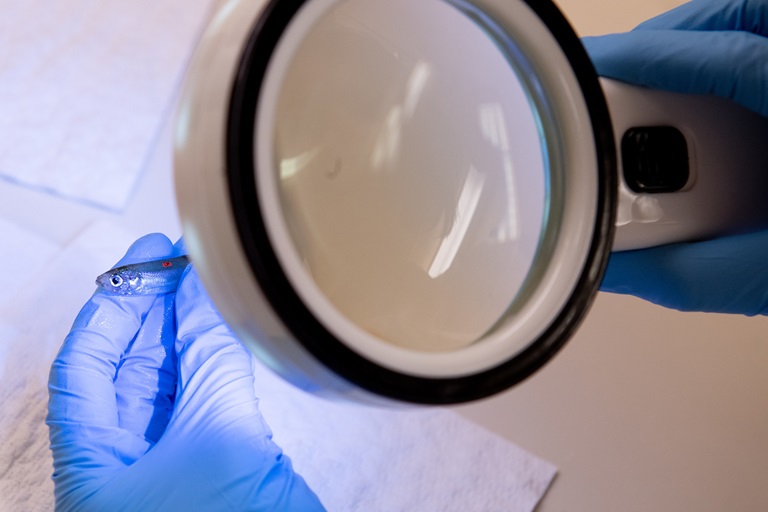DWR Scientist Uses COVID-19 Diagnostic Testing Technology to Help Protect Endangered Fish Species
Researchers at DWR's Division of Environmental Services dissect Delta smelt as part of a study to monitor the effects of introducing hatchery smelt into the wild. The study placed 360 smelt in metal enclosures in a channel off the Sacramento River for one month. DWR/2019
A scientist within the Department of Water Resources’ (DWR) Division of Environmental Services (DES) has found a way to use gene-editing technology, most recently used for COVID-19 diagnostic testing, for ecological monitoring of threatened fish.
“I believe this technology will transform how we accurately identify species, subspecies, or even finer-scale taxonomic levels,” said Dr. Melinda Baerwald, DWR scientist and study project manager. “This new technology will enable DWR to accurately identify threatened species in almost real-time.”
The Clustered Regularly Interspaced Short Palindromic Repeats technology, or CRISPR for short, has been around since the 1990s and has been used to accurately identify specific DNA sequences and break them apart for gene-editing.
The CRISPR-based detection platform SHERLOCK (Specific High-sensitivity Enzymatic Reporter Unlocking) was recently authorized by the FDA to be used to try and figure out who is infected with the novel coronavirus.
“In the past, CRISPR has been used for human disease testing like Dengue, Zika, and COVID, but after some investigating, I realized the potential this sort of technology could have for ecological monitoring as well,” said Baerwald. “Our study is the first to use SHERLOCK in an ecological context.”
This current DWR study uses CRISPR-based SHERLOCK technology to pull DNA from mucus swabs of fish to determine the exact species of fish.
“We collect mucus through non-invasive swabbing techniques,” Baerwald said. “Then we use the DNA in the mucus to identify species (and other levels of genetic differentiation between Chinook Salmon and Smelt run types) with high accuracy and high speed.”
CRISPR-based SHERLOCK technology will allow quicker decision making at the state and federal pumping projects that deliver water to millions of Californians. Staff will now be able to determine if endangered fish species are ever entrained - swept along with the flow - by project operations.
“Pumps need to be reduced if endangered species such as winter-run Chinook Salmon or Delta Smelt are entrained. It is impossible to visually determine whether an entrained salmon or smelt belongs to an endangered run type, but a SHERLOCK test would allow operators to know within minutes,” Baerwald said.
SHERLOCK can provide results within 20 minutes and be deployed in the field with either a handheld fluorescence reader or with a lateral flow strip that works like a pregnancy test, showing a band on the strip if the target species is present.
Baerwald has been actively working on the CRISPR-based SHERLOCK study since 2018, and her findings were recently published in the journal of Molecular Ecology Resources . The study was funded by DWR and is a collaborative effort with the Genomic Variation Laboratory (GVL) at UC Davis and the MIT Broad Institute.
